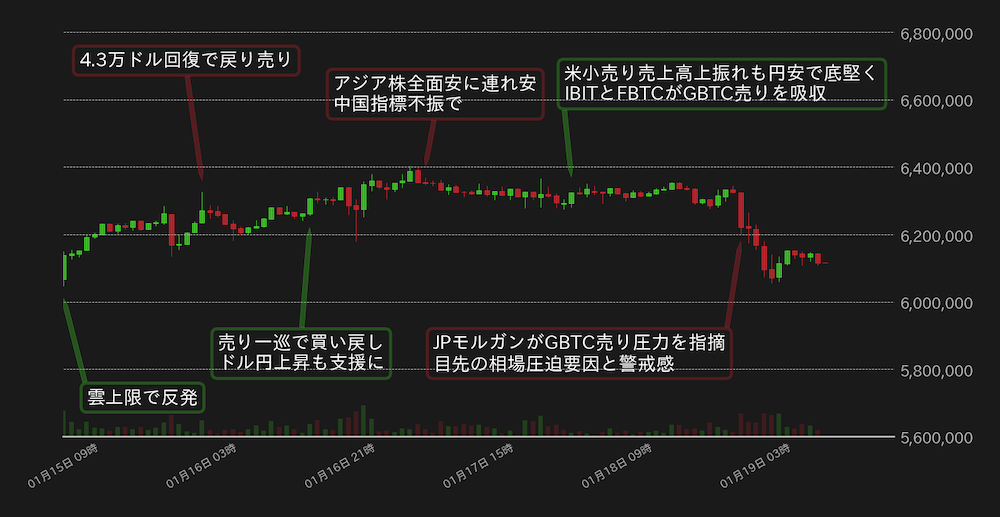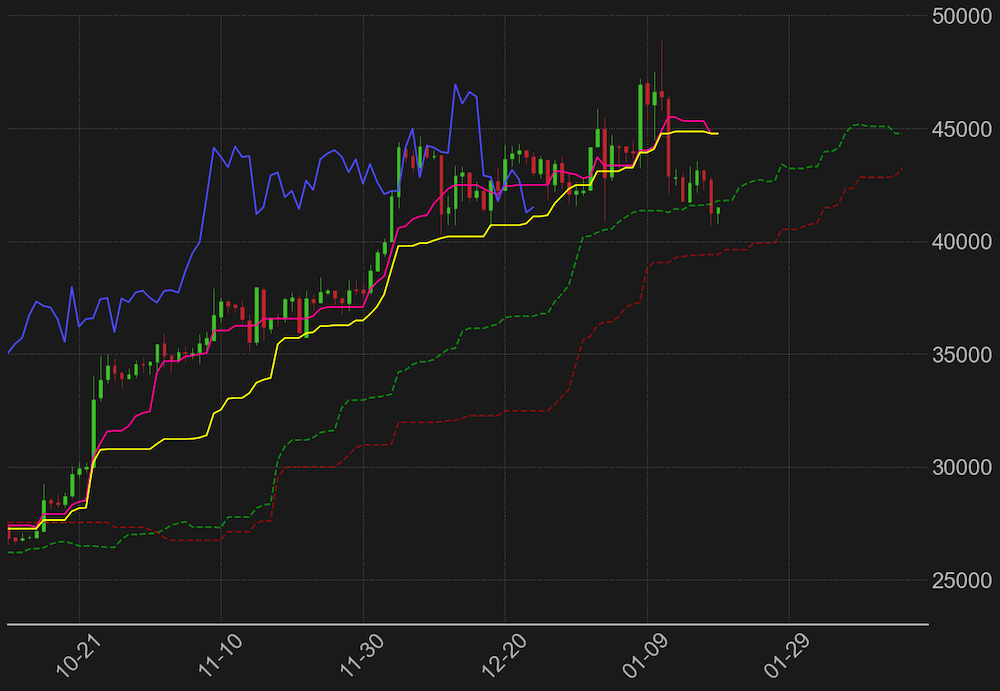
Virtual currency market prices this week from 1/13 (Sat) to 1/19 (Fri)
Mr. Hasegawa, an analyst at Bitbank, a major domestic exchange, illustrates this week’s Bitcoin chart and deciphers the future outlook.
table of contents
- Bitcoin on-chain data
- bitbank contribution
Bitcoin on-chain data
Number of BTC transactions
Number of BTC transactions (monthly)
Number of active addresses
Number of active addresses (monthly)
BTC mining pool remittance destination
Exchange/Other services
bitbank analyst analysis (contributed by Tomoya Hasegawa)
Weekly report from 1/13 (Sat) to 1/19 (Fri):
Bitcoin (BTC) vs. yen is almost flat this week. As of noon on the 19th, the market price was hovering around 6.1 million yen.
At the beginning of the week, BTC rebounded at the upper limit of the cloud on the Ichimoku Kinko Hyo, but the selloff associated with the start of trading in spot Bitcoin Exchange Traded Funds (ETFs) in the U.S. came to an end, and the price continued to rise until the middle of the week.
On the other hand, the dollar-denominated stock had been trading heavily at around $43,000, but on the 17th it turned moderate as Asian stock markets fell across the board due to the downturn in Chinese economic indicators.
On the 17th, U.S. time, there was a moment when the price was on the decline due to the upward trend in retail sales in December, but the impact of the strong dollar and the weak yen, as well as the feared outflow of funds from GBTC, led to a black market. The market was supported by offsetting inflows to Rock and Fidelity ETFs (IBIT and FBTC), and BTC was trading around 6.1 million yen.
However, the following day, on the 18th, a JPMorgan analyst pointed out that the outflow of funds from GBTC would have an impact on the BTC market for the time being, and the market price widened, dropping to around 6.05 million yen at one point. However, as mentioned above, GBTC’s selling pressure has been absorbed by BlackRock and Fidelity, and considering the remaining eight ETFs, net inflows of approximately $470 million were confirmed in the first four days of trading. From the 19th, Asian time, the market has been testing for a rebound.

Figure 1: BTC vs. Yen chart (1 hour timeframe) Source: Created from bitbank.cc
Selling pressure due to GBTC conversion into ETFs has been a concern in some quarters for some time, and in fact, an outflow of BTC worth $1.78 billion has been confirmed so far. However, since ETF trading began, the daily trading volume of spot BTC is approximately $21 billion to $52 billion in dollar terms (according to CoinGecko research).
Furthermore, considering that there is a net inflow of funds into the ETF as a whole, the actual selling pressure on GBTC can be said to be slight.
That said, BTC has fallen below the upper limit of the cloud on the Ichimoku Kinko Hyo, which was the support at the beginning of the week in dollar terms, so we should be careful about the possibility of a test of the downside in the near term.
However, in the near term, the price is just below the current level, with the psychological milestone of $40,000, the Chicago Mercantile Exchange (CME) futures market at the window that opened in December at $39,600, and the lower cloud limit of $39,500. We believe that there is a lot of support, and the downside room for the market is limited.

Figure 2: BTC vs. USD Ichimoku Kinko Hyo (daily chart) Source: Created from Glassnode
On the other hand, in the federal funds rate futures market this week, expectations for an interest rate cut in March have receded due to a series of solid US economic indicators. Until last week, there was more than a 70% probability that interest rates would start cutting in March, but that has now fallen to 53%.
As a type of commodity that does not generate interest, such movements are negative for BTC, but as previously pointed out, the market was “over-priced” in the Fed’s early interest rate cut, so even if the Fed decided to keep interest rates unchanged in March. In a sense, this can be said to be a healthy move, as it reduces the possibility of it being a surprise.
The US CPI for December, which was announced last week, remained high at 3.4% compared to the previous year, accelerating from 3.2% in November. While the medium- to long-term trend is that inflation is still on the decline, it is overly optimistic to think that it will reach the Fed’s 2% target by March.
Considering the above, the BTC market is expected to develop in a directionless manner over the medium term. It has been pointed out that the downside is likely to be firm due to the move to factor in Bitcoin’s halving scheduled for April, but the upside is likely to be limited until the timing of the Fed’s interest rate cuts comes into view.
Next week will be a media blackout period ahead of the US Federal Open Market Committee (FOMC) meeting on the 31st, with no comments from senior Fed officials. In terms of economic indicators, preliminary figures for the fourth quarter GDP growth rate of 2023, the personal consumption expenditure (PCE) price index for December, and important indicators are scheduled for Thursday and Friday, so will the market start to move towards the second half of the week?
connection:bitbank_markets official website
Previous report:Approval of Bitcoin ETF sells the facts, and there is a feeling of running out of materials
The post Bitcoin is developing without a sense of direction, with a heavy top price and limited downside room | Contributed by a bitbank analyst appeared first on Our Bitcoin News.

 1 year ago
137
1 year ago
137















 English (US) ·
English (US) ·